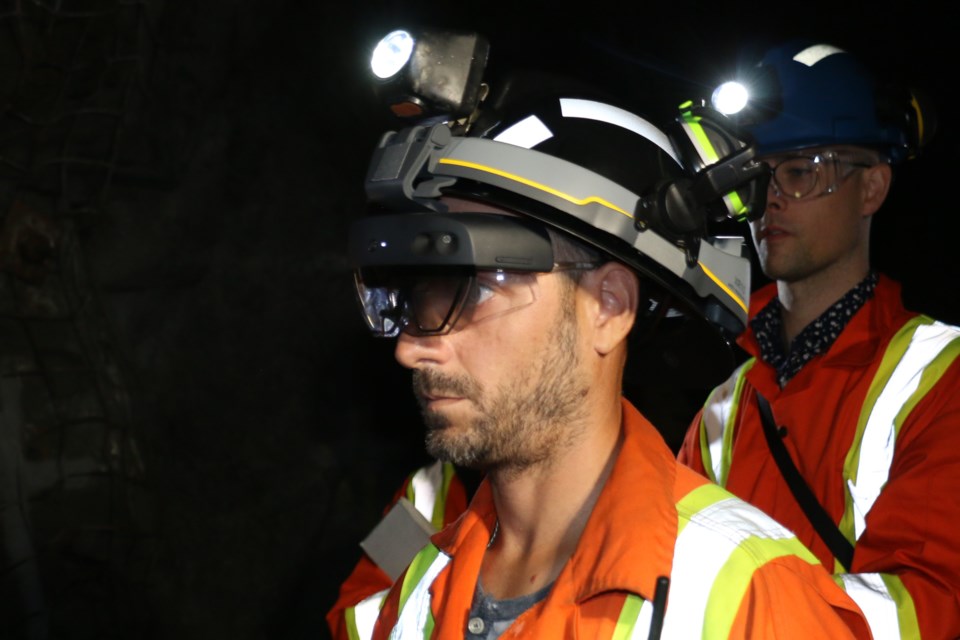Sudbury continues to strut forward as a centre for advanced mining technology. That was evident today when a new type of mining helmet was showcased to the Sudbury media during a quick tour of the NORCAT Underground Centre.
The event was hosted by Cambrian College's Applied Research division, NSS Canada (Northern Survey Supply) and NORCAT, which operates an underground mine in Onaping.
The project will allow NSS to install the Microsoft HoloLens-2 AR (augmented reality) system onto miner's hardhats.
The whole idea, said Mike Commito of Cambrian College, is to make mining safer and easier for underground workers.
“The AR system could make underground mining safer by allowing miners to operate machinery at a greater distance away from the mining face, reducing the risk of being hit by falling or flying rock or other debris,” Commito said.
“We’re very excited to see what we can come up with, because a small harness might have big implications for the use of AR underground and mining safety in the process.”
One of the challenges for the researchers at the moment is that the harness for the HoloLens does not adapt to a standard mining helmet.
Bruno Lalonde, president of NSS Canada, said the current harness used on helmets is designed for surface work. He said in order to make it work for mining applications, the company approached Cambrian College for a solution.
Commito, the Director of Applied Research & Innovation at Cambrian College, said the system has been designed for hardhats used in civil engineering, but not yet for mining. He said mining helmets need to allow for cap lamps as well as hearing protection.
"It's designed for different helmets. But obviously within mining there's certain regulations with the types of helmets that you would see underground, whether it's a shaft helmet, or a production helmet, but you also have to deal with the challenge of you have with your PPE on your hard hat, such as your hearing protection, or your cap lamp," Commito explained.
Committo added that one of the objectives is to create a helmet that is useful and comfortable for miners, so that they don't reject the helmet as being too heavy or hard to use.
"I mean anytime you're adding additional gear, there is certainly certainly additional weight that you're putting on which could provide some discomfort. So I think that's part of what we're hoping to tackle as well though, we already know that we're going to have to engineer something that I think is lightweight but sturdy enough to hold the HoloLens," he added.
The research team demonstrated how the new HoloLens-2 system can be used with the MOSS (Miner Operated Survey System) to map out the face of a new round on a development heading. The face is the actual working area - the rock wall - where miners map out their drilling plan and then drill into the face.
The conventional method is to use a can of spray paint to mark off where the drill holes need to be in order to advance the drift heading. It means a miner has to stand up close to the new rock face.
The new tech approach uses the HoloLens-2 to help the miner map out the new round and drill pattern by pointing his finger at the rock face and lining it up with the HoloLens-2 to draw the outline of the drift (tunnel) using gesture control.
NSS general manager Matthew Brown said the HoloLens-2 follows the gestures and uses special software and MOSS technology that determines the best possible drill pattern
The upshot is that the miner does not have to stand beside the freshly-blasted rockface, which can be dangerous in some circumstances.
The plan is for Cambrian students to begin working with NSS team members to come up with a design for the new helmet, including all the safety measures, and to have a working prototype within two months.
“We love working with Cambrian R&D because they have the facilities and expertise to help us solve our real-world problems in real time,” said NSS president Lalonde.
“It also gives us the opportunity, as a company, to find and recruit new talent.”
– Sudbury.com
